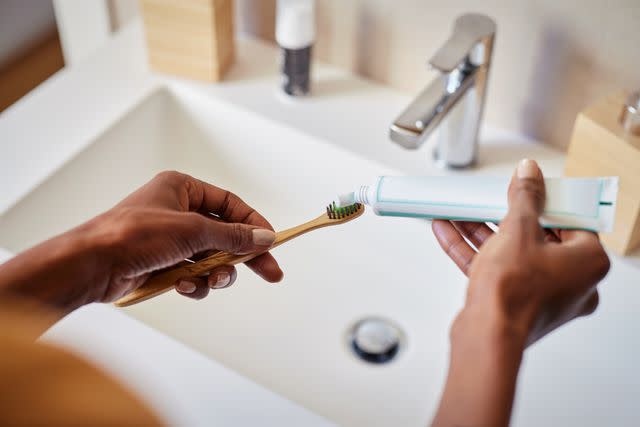What Is Plaque? A Complete Guide to the Sticky Film on Your Teeth
Medically reviewed by Brian T. Luong, DMD
Plaque is a clear, sticky coating of bacteria that sticks to your teeth. Scientists call plaque a biofilm, clusters of bacteria that attach to a surface or each other and have survival strategies that help them evade your body's defense systems.
Untreated plaque buildup can lead to tooth decay and periodontal (gum) disease. Fortunately, good oral hygiene and dental care can help remove and prevent plaque on teeth.
This article covers the difference between dental plaque and tartar, the causes and signs of plaque, and treatment and prevention.

Ridofranz / Getty Images
Dental Plaque vs. Tartar: What’s the Difference?
The terms "plaque" and "tartar" are sometimes used interchangeably. But they are not the same thing.
Dental plaque is a sticky film that forms on teeth. Plaque develops when leftover food and saliva accumulate in your mouth and teeth and aren't adequately brushed off. Foods rich in sugars and carbohydrates will most likely lead to plaque buildup.
Tartar, on the other hand, occurs when minerals from your saliva accumulate on top of plaque. This hardens over a few days. Unlike plaque, which you can remove at home, tartar is too hard and requires the help of a dental hygienist.
What Causes Plaque?
Several factors can lead to plaque development, including:
Eating too many carbohydrates
Poor oral hygiene habits
Diet and lifestyle choices
Genetic factors and predisposition to plaque
Frequently eating starchy and sugary things creates an environment where plaque can grow and thrive. That's because simple carbs promote the overgrowth of bacteria.
In addition, eating too few nutritious foods can lead to more plaque. Not eating enough nutrient-dense foods, like fruits, vegetables, lean meats, whole grains, and dairy, increases the risk of dental caries (tooth decay or cavity) and oral diseases.
Some people are genetically predisposed to plaque. The genes most commonly associated with tooth decay involve enamel formation, tooth mineralization, immune response, salivary characteristics, and taste.
How to Tell If You Have Plaque
If you have dental plaque, you may notice the following:
A fuzzy feeling on your teeth
If you want further confirmation, you can take at-home tests to identify plaque. Some of these kits use special tablets that you chew and then move the mixture over your teeth. The presence of plaque then shows up as red.
Another at-home method involves using a plaque light. After swirling a fluorescent solution around your mouth, you shine a special ultraviolet plaque light into your mouth. Areas covered in plaque show up as a bright yellow or orange.
For a definitive diagnosis, you'll need to visit a dentist. A dentist or hygienist can examine your teeth closely with special tools.
What Happens If Plaque Is Not Removed?
Untreated plaque can lead to periodontal disease. Gingivitis is the most common form of gum disease. It is a reversible form of gum disease caused by plaque.
If gingivitis is left untreated and advances, it can become a more serious form of gum disease called periodontitis. This condition is characterized by inflammation that damages surrounding tissue and bones. The damages may be irreversible, so treating gingivitis is very important.
Plaque can also lead to systemic health issues. Researchers found links between gum disease and the following health conditions:
Heart disease
Respiratory disease
Not removing plaque can also cause tooth decay. That's because plaque acids damage tooth enamel. This can cause holes (cavities) in your teeth.
Related: Your Mouth Has a Lot to Say About Your Overall Health
What’s the Treatment for Plaque?
Dentists and hygienists treat plaque with special tools to remove it. These instruments may include the following:
Hand instruments for scaling (scraping) the teeth
Ultrasonic instruments that use vibrations
Perioscopy, a tiny scope that can peer between the gums and teeth
The best way to treat plaque is by removing it at home before tarter hardens over it.
How to Remove Plaque From Teeth
You can usually remove plaque at home with adequate oral hygiene practices. If you notice plaque buildup, try the following:
Brush your teeth twice a day for at least two minutes.
Floss once a day.
Use cleaning tools such as dental picks and water flossers.
Get regular dental cleanings and checkups.
How to Prevent Plaque Buildup
Prevention is your best bet when it comes to plaque. Good oral hygiene and a nutritious diet can go a long way. Brushing and flossing regularly are the best defense against plaque buildup. Experts recommend the following flossing technique:
Wrap a strand of floss around your two middle fingers.
Hold the floss tightly between your thumb and forefinger.
Guide it gently between your teeth with a rubbing motion.
When the floss reaches the gumline, curve it against one tooth and slide it up and down.
Repeat on all teeth.
In addition to good oral hygiene at home, get regular dental cleanings. These visits catch the things you don't at home and remove any buildup you've missed. You may also benefit from antimicrobial mouthwashes that can kill bacteria and maintain healthy gums. Just avoid those that contain alcohol.
Limit your intake of sugary foods and drinks and simple carbs. Eating these foods in moderation alongside a balanced diet can help you maintain a healthy mouth.
Summary
Plaque is a sticky film that builds up on teeth. You can usually get rid of it at home if you address it before it gets covered by tartar, which is too hard to remove at home. Good oral hygiene, including brushing twice a day, flossing every day, limiting sweet drinks and food, and getting routine dental cleanings, are all ways to prevent and treat dental plaque.
Read the original article on Verywell Health.

